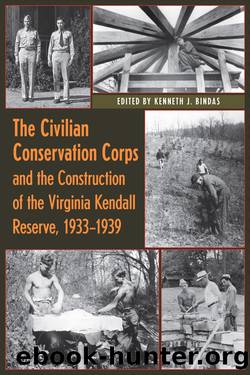The Civilian Conservation Corps and the Construction of the Virginia Kendall Reserve, 1933 - 1939 by Bindas Kenneth J.;

Author:Bindas, Kenneth J.;
Language: eng
Format: epub
Publisher: The Kent State University Press
Kendall Lake construction, 1936 (National Park Service)
The appropriation of modernist language in their official documents reveals Wagner and his design teamâs commitment to transforming the reserve through rational planning, simple utilitarian structures, and efficient organization.13 This understanding of and complicity with modernist ideology is also reflected in Wagnerâs letters to various regional and state agencies. In a 1938 letter to the regional officer of the Branch of Planning and State Cooperation, Wagner discussed the completion of shelters on the reserve, writing that âyou will agree that from the standpoint of utility and appearance, the structure as designed will serve the purpose which is demanded,â and further, it âhas been in constant use throughout the past summer and not only has given excellent service, but is also the subject of a great deal of favorable comment on the part of lay people and architects alike.â Wagner made a point of outlining the shelterâs utility, as well as its general approval by the local population. The CCC never deviated from its core mission of salvaging the environment, providing employment, and creating modern, natural, and useful recreation spaces for the American public.14
These goals applied to the reserve, as Smith reported to the regional office in 1936, commending his people at all levels for their adherence to sound practice, organization, and planningâall aspects of the modernism that resulted from industrialization. Smith wanted the CCC to develop âadequate picnic grounds and the ample provision for the parking of automobiles.â He also reported that it was important to maintain the already established âfoot paths [which] have tapped large areas hitherto inaccessible and consequently have increased the number of devotees of these outdoor activities.â Even the War Department, which oversaw the daily operation of the camp and its recruits, commented on the modernist features of the reserve.
In their 1935 report, they pointed out that their success was due mainly to the âsound organizationâ of the camp, as each branch worked much like the âwell-oiled machineâ Commander Belden had sought to create with the CCC boys. The Department of the Interiorâs report on CCC work in 1935 agreed, outlining how âspecific work projects which have been completed will aid field officers of the National Park Service in an effective manner to conserve and preserve natural features.â Each of these reports used modernist language in documenting the planning and functional use of enrollees and equipment and served as a testament to the CCCâs goals of redefining and mastering nature. Other governmental departments and agencies under the CCC umbrella reflected the âsoundnessâ and organization that Smith, the War Department, and the Department of the Interior reported in their official reports. The reserve was not unique in this as these ideals were part of the larger function of the CCC throughout the United States.15
Download
This site does not store any files on its server. We only index and link to content provided by other sites. Please contact the content providers to delete copyright contents if any and email us, we'll remove relevant links or contents immediately.
Kathy Andrews Collection by Kathy Andrews(10573)
The remains of the day by Kazuo Ishiguro(7588)
Spare by Prince Harry The Duke of Sussex(4236)
Paper Towns by Green John(4183)
The Body: A Guide for Occupants by Bill Bryson(3843)
Be in a Treehouse by Pete Nelson(3242)
Harry Potter and the Goblet Of Fire by J.K. Rowling(3107)
Goodbye Paradise(2989)
Never by Ken Follett(2922)
Into Thin Air by Jon Krakauer(2718)
The Remains of the Day by Kazuo Ishiguro(2632)
The Genius of Japanese Carpentry by Azby Brown(2621)
The Cellar by Natasha Preston(2611)
Drawing Shortcuts: Developing Quick Drawing Skills Using Today's Technology by Leggitt Jim(2539)
120 Days of Sodom by Marquis de Sade(2451)
Architecture 101 by Nicole Bridge(2359)
Machine Learning at Scale with H2O by Gregory Keys | David Whiting(2333)
The Man Who Died Twice by Richard Osman(2317)
Industrial Automation from Scratch: A hands-on guide to using sensors, actuators, PLCs, HMIs, and SCADA to automate industrial processes by Olushola Akande(2196)
